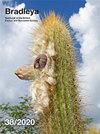盘仙人掌(Discocactus zehntneri Britton)和玫瑰(Rose subsp。petr halfarii(Zacar)M.R.Santos和M.C.Machado(仙人掌科),一种极度濒危的巴西仙人掌亚种
IF 1.2
4区 生物学
Q3 PLANT SCIENCES
引用次数: 1
摘要
摘要:大仙人掌(discactus zehntneri Britton & Rose)亚科。petrohalfarii (Zachar) M.R. Santos和M.C. Machado(仙人掌科)是一种极度濒危的巴西仙人掌亚种。其种群结构和物候模式尚无相关资料。因此,本研究表征了该亚种的种群结构,并确定了该亚种的物候模式和萌发行为。我们对种群中的所有个体进行标记,并测量其直径,将其划分为4个年龄类别:幼苗、幼苗、茎部(直径0 ~ 5cm无头)和生殖植株。为了进行物候评价,我们选择了50种植物。我们连续两年每月监测这些植物。对于每种植物,我们观察了生殖结构的数量,并将它们与气候数据进行了关联。我们发现1975个个体以亚种群的形式分布在800到2000平方米的范围内。以幼苗和幼体居多,成虫约占总株数的25%。花期从11月开始,一直延续到6月,在11月至2月之间达到花期高峰,这两个月降雨量较高,气温最高。结果期较短,强度较低,发生在12月至4月。163朵花中只观察到37个果实(22.7%),种子萌发仅在光照条件下进行(>90%)。结果表明,该仙人掌亚种有明确的花期和结果期。繁殖植物、果实和种子少,可能影响物种在环境中的维持。本文章由计算机程序翻译,如有差异,请以英文原文为准。
Population structure and phenology of Discocactus zehntneri Britton & Rose subsp. petr-halfarii (Zachar) M.R. Santos & M.C. Machado (Cactaceae), a critically endangered Brazilian cactus subspecies
Summary: Discocactus zehntneri Britton & Rose subsp. petr-halfarii (Zachar) M.R. Santos & M.C. Machado (Cactaceae) is a Critically Endangered Brazilian cactus subspecies. There is no information on its population structure and phenological pattern. Thus, this study characterises population structure and determines the phenological pattern and germinative behaviour of this subspecies. We marked all individuals in the population and measured their diameter to create four age categories: seedling, juvenile, stem >5cm diameter without cephalium and reproductive plant. To carry out phenological assessments, we selected fifty plants. We monitored the plants monthly for two years. For each plant, we observed the number of reproductive structures and correlated them with climatic data. We found 1975 individuals grouped in subpopulations that grow in areas ranging from 800 to 2000m2. Most individuals were seedlings and juveniles, and adult plants accounted for about 25% of the population. The flowering period started in November and extends to June, peaking in flower production between November and February, the months with higher rainfall and maximum temperatures. Fruiting was shorter, less intense and occurred between December and April. We observed only thirty-seven fruits in 163 flowers (22.7%) and recorded seed germination only in the presence of light (>90%). The results indicate that this cactus subspecies has a well-defined period of flowering and fruiting. Reproductive plants, fruits and seeds are few, which may affect the species maintenance in the environment.
求助全文
通过发布文献求助,成功后即可免费获取论文全文。
去求助
来源期刊

Bradleya
PLANT SCIENCES-
CiteScore
2.80
自引率
25.00%
发文量
43
审稿时长
>12 weeks
期刊介绍:
Bradleya is the BCSS contribution to the scientific world and is accepted as such because of its academic standards. It can only flourish with the support of BCSS members, many of whom subscribe to it each year. The aim is to include articles which our members will find interesting and educational, whilst retaining rigorous standards of publication. Scientifically important articles don''t have to be dull to read. So, because Bradleya depends the subscriber, the editor endeavours to make its contents accessible, easily understood and enjoyable for all.
 求助内容:
求助内容: 应助结果提醒方式:
应助结果提醒方式:


